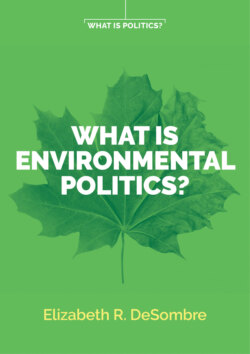Читать книгу What is Environmental Politics? - Elizabeth R. DeSombre - Страница 7
What is the Environment?
ОглавлениеFor a term that is so frequently used, it can be surprisingly difficult to pin down what “the environment” means. Some people use it to refer to nature and the various amenities that nature provides: plants, animals, soils, air, water, even sunlight. But the concept is broader than that and changes as we imagine different human activities and learn more about global systems, from the smallest to the largest scale. We now understand the importance of microbes and of the stratospheric ozone layer in protecting life on earth. At the same time, human constructs such as buildings and cities, or practices such as agriculture or industrialization, form part of what we are thinking of when we talk about the environment.
What we are generally discussing when we look at the environment is how human activity influences it, and is influenced by it. One useful framing is to think of the environment in this context as being partly about pollution, which occurs when contaminants or other unwanted substances are introduced (usually unintentionally) into air, water, or land as a byproduct of other activity. It is also partly about the use of resources, things taken out of their environmental context for human use. These resources may be renewable or non-renewable.
Pollution is pervasive. It includes everything from waste dumped intentionally into the ocean to fumes from factory smokestacks to agricultural runoff into rivers. We can even speak of light pollution or noise pollution to refer to unwanted intrusions into our surroundings that affect the wellbeing of people or other species.
Some pollution is obvious. We can see or smell it. We may know its causes and be able to feel its effects. Other types of pollution, however, are less apparent. Water that is contaminated by lead or other heavy metals may be toxic to people and animals, but it may look or taste no different than clean water. Greenhouse gases – carbon dioxide and other emissions that contribute to global climate change – are substances that, on their own, aren’t necessarily harmful to breathe. Collectively they nevertheless contribute to the overall warming of the planet and the many related effects such as drought and sea-level rise. The chlorofluorocarbons (CFCs) that contributed to the destruction of the ozone layer were non-toxic and stable and invisible in the air. Pollution, in other words, is defined by the harm it causes, but we may not always be aware of that harm when we are creating or experiencing it.
Natural resources also form a part of what we think of as the environment. Overuse of natural resources is an important category of environmental problems. Some natural resources are what we call “non-renewable.” On human time-scales the earth will not make any more of these materials than currently exist. Non-renewable resources include things such as fossil fuels – the coal, oil, and gas that are so central to our energy use – as well as minerals such as copper and tin, or even the rare earth elements (for example, neodymium) that are important in our cell phones and other technology.
Other types of natural resources – such as fish or forests – are what we call “renewable.” You’d think that use of renewable resources would be less problematic than use of non-renewable resources. After all, if you leave enough fish or trees around, they make more fish and trees. But it turns out that we often do extract these far beyond their ability to be renewed.
There is more to the environment than decisions about endangered species or factory pollution; these include factors such as urbanization or agriculture. At this point in ecological history, humans have shaped almost every aspect of the earth’s processes, so much so that geologists and others argue that we’ve entered a new geologic age: the Anthropocene. This era is named to reflect the pervasive influence of humans on global processes. Those effects are all relevant to a consideration of what the environment is.
Also relevant are questions of who the environment is for. When we’re concerned about protecting the environment, do we care only about ensuring its best uses for the wellbeing of people, or do we care about species or resources for their own sake? From the point of view of environmental politics, the focus is most frequently on people, because people are the decision makers, and because politicians are elected or otherwise maintained in power by the support of the people they govern. But species and ecosystems may matter in their own right and not just for their instrumental value to human beings, and some people do focus on the wellbeing of the environment or of certain species for the sake of ecosystems or those species and engage in environmental politics to protect them.
Even if we are concerned about the condition of the environment primarily for the sake of people, we need to ask which people bear the brunt of environmental problems. The concept of environmental injustice has been framed to call attention to the fact that some of the most vulnerable populations are the most likely to suffer the worst consequences of environmental problems and have the least voice in the creation of policies to address the environment. An understanding of characteristics of both politics and the environment can help us appreciate why it is that environmental problems are often concentrated in communities with the least political power.
